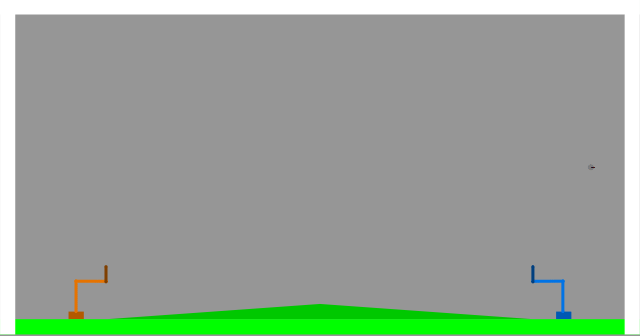Challenge #1: Ball Passing

You get points for touching the ball
with the hand of the same color as the ball.
You lose points for touching anything else,
or for the ball touching anything else.
There is a small additional cost to the
torque you apply (so it's better to be relaxed).
Your AI has to play without your help.
However, it does NOT have to run in real time.
This is a cooperative challenge, so submissions
must include source and a description of the approach.
Please give credit when including others' ideas and code.
The challenge will be considered won once we can
maintain a net-positive score, but
it will remain open indefinitely to improvements
and alternate approaches.
The current environment code is available on the main page
Or use "svn checkout http://invivo.googlecode.com/svn/trunk/ invivo"
(Or if you prefer C# and .NET, try this instead:
"svn checkout http://invivo.googlecode.com/svn/extras/dotNet invivo")
It's in python, and you'll need to get
pygame and pybox2d installed to make it work.
(You'll also need python-ming if you
want to generate flash animations.)
There is a very simple JSON network interface
if you wish to implement your solution
in some other language.
Email me if you plan to participate and/or
want an invite to the project's mailing list.
-Simon (simonfunk@gmail.com)
This is the interface to each bot:
Here is a sample controller (the one shown in the above animation). This is the ONLY file you should change:
import math class Controller(object): "Test controller for Interface01." def __init__(self, interfaces): "Interfaces is a pair of Interface01 objects." self.bots = interfaces def update(self, time): self.foo(self.bots[0], time) self.foo(self.bots[1], time*1.234 + 10.) #self.bar(self.bots[1]) def bar(self, bot): for i in range(3): bot.torques[i] = -bot.angles[i] * 3. - bot.angvel[i] * .01 def foo(self, bot, time): bot.torques[0] = math.sin(time ) * bot.torquesmax[0] bot.torques[1] = math.sin(time*1.7) * bot.torquesmax[1] bot.torques[2] = math.sin(time*2.3) * bot.torquesmax[2]